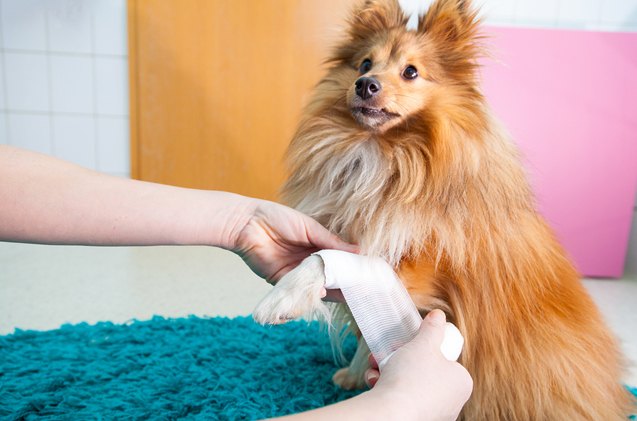Is Neosporin Safe for Dogs?

Just like any other member of your home, dogs are prone to minor injuries like cuts, scrapes, and burns. It happens, not matter how hard that you try to prevent. That’s just part of life. Sure, in many cases your dog’s thick fur will protect him from these injuries, but accidents do happen. When they do, you want to clean and treat the wound as quickly as possible to prevent infection. Neosporin is what most people use to protect their own wounds from infection, but is it safe to use for your dog? Or should you avoid it all costs? There’s only one way to find out! Keep your eyes glued to this page and scroll away. All will be revealed.
First of All: What Exactly is Neosporin?
Neosporin is the brand name for a topical antibiotic typically used to prevent infections for minor skin wounds such as cuts, scrapes, and burns. The generic names for Neosporin include bacitracin, neomycin, and polymyxin. The main purpose of Neosporin is to hinder the growth of infection-causing bacteria when applied to minor wounds, but some forms also offer analgesic properties. When used properly, not only can Neosporin prevent infection, but it may also help to speed the healing process. There’s a reason why Neosporin has been stocked in pharmacies for decades. This is a vital product that prevents infection and ensures that minor wound remain minor problems.
Related: How to Treat 4 Common Canine Skin Injuries and Irritations
Now, The Big Question: Can You Use Neosporin on Dogs?
When your dog sustains a minor injury your first instinct might be to reach for an antibacterial cream such as Neosporin, but unfortunately you should think twice before you do. First of all, you need to consider whether an antibacterial cream works the same way on a dog’s skin as it works on human skin. The short answer is yes. Thankfully, Neosporin will still help to create a physical barrier against bacteria entering the wound and it offers antibacterial properties to prevent infection as well.
However, it is important to remember that for both dogs and humans, Neosporin is not for the treatment of deep cuts or major wounds. If your dog is bleeding heavily you need to apply a compressive bandage to control the bleeding and take your dog to the emergency vet for stitches. Serious wounds require more serious attention that Neosporin could possibly provide. So, be sure to assess the situation carefully before reaching for your tube of Neosporin.
Related: 5 Alternatives to the Dreaded Cone of Shame
Something else that you need to think about is that dogs tend to heal very quickly from superficial wounds. In fact, the heal far faster than humans do. This being the case, a topical ointment like Neosporin may not even be necessary (though it certainly won’t hurt if you are concerned). You can apply Neosporin as an added layer of protection, but only apply a small amount two to three times per day until the wound is fully healed. Again, dogs don’t heal like humans and applying too much Neosporin could disrupt the healing process. It’s important to be careful about this to avoid creating new problems.
So, just remember: if you are dealing with something minor, like a little scrape, regular Neosporin might be a good idea. Open wounds, bites from other animals, and other major injuries should be examined by your veterinarian, who can provide the best treatment to avoid infection and complications. It’s always best to differ responsibility to a vet in these scenarios to ensure that the situation is handled with the appropriate level of care.
If your dog has seen the vet and received stitches to close a wound, or if he has undergone surgery recently and he got stitches, you should not use Neosporin. It might be tempting, but it’s incredibly important to avoid your Neosporin tube in this scenario. If you notice that there are any problems with the surgical site, such as an issue with the stitches, contact your vet’s office to let them know, and to find out what your next steps should be to prevent complications.
Also, consult with your vet if there are other symptoms, such as itching and redness, before applying Neosporin to the wounded area. And, when it comes to your dog’s paw pads, keep in mind that your dog will likely lick his paws often, so Neosporin probably is not the best idea for paw pad injuries, as you don’t want your pet ingesting too much of the ointment, or licking it off the wound before the medicine can really do its job. So keep those paw pads clean. It’s simply not worth using Neosporin in these scenarios given the potential negative side effects.
And bear in mind that Neosporin should NEVER be applied near a dog’s eyes. This even includes applying it in the corners of the eyes and it also should not be applied inside a dog’s ears either. If there is an eye infection or an ear infection present, your vet can advise you on how to resolve the problem. Neosporin is never the correct solution in these instances.
Tips for Applying Neosporin Correctly
When it is okay to use Neosporin, it is best to clean the wounded area with some warm water or a saline solution before you apply the ointment to the injury. And, again, it is a good idea to check in with your veterinarian before you apply the ointment in the first place, just to be sure. When you call your vet, describe your dog’s injury in detail, note any other symptoms that are present, and ask if you need to take any additional steps to help the injury heal. Be very careful about how you handle the situation. Never rush in with your Neosporin. It could make things worse rather than better.
Now, what about extra-strength Neosporin, or any variety of Neosporin that contains additional ingredients, such as those that are added to help relieve pain? Well, again, these products should only be used if your veterinarian has given you the go-ahead to do so. As mentioned above, stick with regular-strength Neosporin if you are going to use it on your dog. It’s simply not worth the risk.
You also need to be sure to cover the wound with a bandage to prevent your dog from licking it and ingesting the Neosporin. When ingested in large amounts, Neosporin and similar antibiotics can cause dangerous side effects including gastrointestinal upset, vomiting, diarrhea, skin lesions, and seizures. It will make your dog incredibly ill when ingested. So, always be careful about where you apply it on your dog and never put it anywhere that your dog can reach with their mouth.
There Are Canine-Appropriate Alternatives Available
If you want to avoid the risk for poisoning altogether, go with a dog-friendly alternative called Vetericyn. It is a wound and skin care spray that is completely safe for dogs, even if ingested. It might be wise to keep this handy rather than using Neosporin as this can be used without any of the fears, but all of the positive effects.
Consider Calling Your Vet First When Your Dog Is Hurt
Even if your dog sustains a minor injury, you should still take care to properly clean and treat the area so it doesn’t become infected. Superficial wounds tend to heal quickly on their own, but deep cuts and serious wounds may require stitches. Don’t take your dog’s health for granted – treat injuries promptly to prevent them from getting infected.
Ultimately, if your dog has an injury that you think warrants the use of an antibiotic ointment like Neosporin, it is a great idea to call your veterinarian first to be sure it really is the right choice. And keep in mind that, just because Neosporin is considered generally safe for use on dogs when used appropriately, it doesn’t mean that this product is safe to use on other animals, such as cats.

Kate Barrington is the loving owner of two cats (Bagel and Munchkin) and a noisy herd of guinea pigs. Having grown up with golden retrievers, Kate has a great deal of experience with dogs but labels herself a lover of all pets. Having received a Bachelor's degree in English, Kate has combined her love for pets and her passion for writing to create her own freelance writing business, specializing in the pet niche.
More by Kate Barrington























